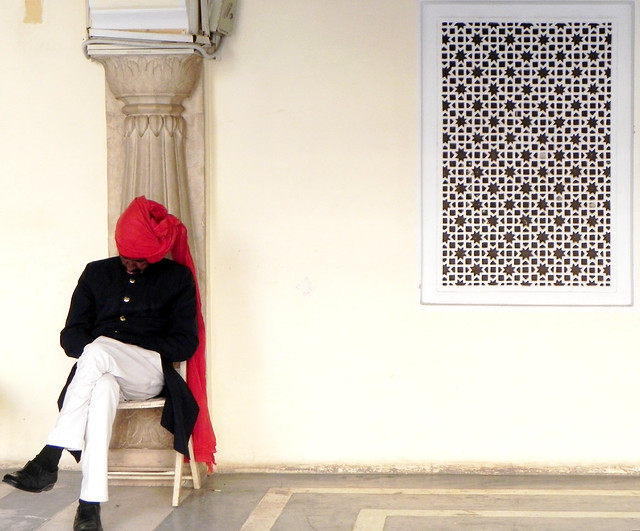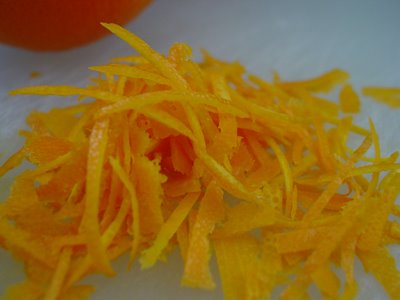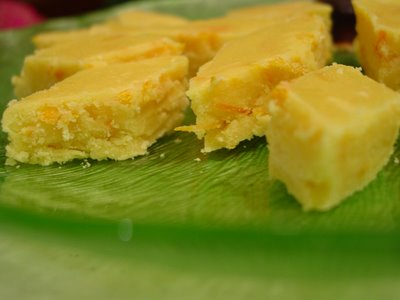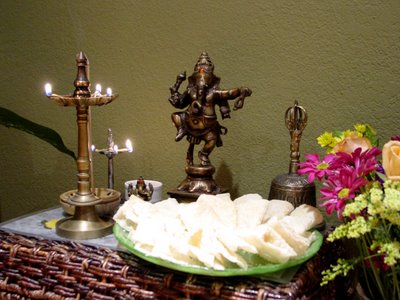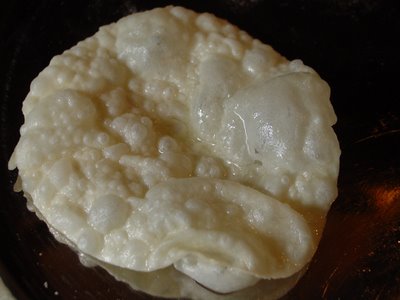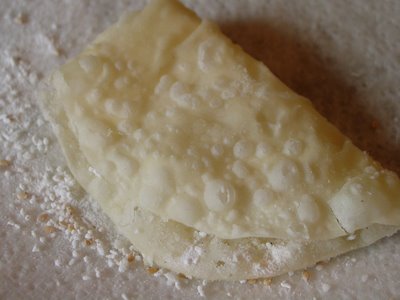Ganpati Bappa morya!
Pudchya varshi lavkar ya!
Ganpati or Ganesh is my favorite Indian God. He's full of mischief yet he's the God we seek blessings from before we start new chapters in our lives.
In our family, we didn't really do much for Ganesh Chaturthi. My mother would make modak, karanji and chavde. The last, I think, was for
my now Buddhist sister who was born on Ganesh Chaturthi many moons ago. Well, like Mom, I made chavde and they were nearly as good as hers!
Also known as mande in Konkani, chavde are like a crunchy puri that has been folded over a deliciously sweet sprinkling of sugar, cardamom and coconut powder. This was such a hit that
naivedya went for a toss. I consoled myself in the same way my mother did: my family is my God. And, since I am part of that family, I crunched away happily on the chavde before offering them to my favorite pot-bellied God.
We sang
Jai Ganesh Deva and
Sukhakharta Dukhaharta and did a little puja. This was followed by a frantic trip to McDonald's to return a Redbox DVD before 7:00 pm. I don't know if they made it in time as I was busy making dinner. Dinner, offered to the Ganpati Bappa first, was waran-bhath, til alu, with lime pickle and, of course, chavda. A little finger was quickly dipped in the lime pickle and I saw it even though my back was turned. But I don't think Bappa really minds...
One Chavda, many chavde
My recipe is an adaptation of
Shanta's recipe,
Shilpa's recipe and what the birthday girl told me over the phone, which in this case, was not very much.
- 3/4 cup sugar, castor sugar or powdered
- 3/4 tsp cardamom powder
- 2 tsp sesame seeds, toasted
- 3 tbsp coconut powder
- Oil for deep frying
- 1 cup maida
- 2 tsp ghee
- 1/2 cup milk

- Powder the sugar in a coffee grinder if you are using regular sugar.
- Mix it with cardamom powder, sesame seeds and coconut powder. Taste the mixture and adjust it to suit your taste-buds.
- Heat the oil
- Mix the maida, ghee and milk and knead into firm dough. If the dough feels soft or sticky, add more maida till it is very firm.
- Make small doughballs about the size of a quarter and cover with a damp paper towel so that the dough does not dry out.
- Set up two stations: one to roll out the puris (rolling station), another by stove (deep frying station). Place the sugar mixture by the second station and also prepare a large platter with at least 2-3 layers of paper towels. Also keep an extra paper towel handy. You will need another empty platter for the chavde when they are ready.
- Roll out thin puris about 5 inches in diameter. Make them in batches of 10 each, keep them covered with a damp paper towel till you are ready to move to the deep frying station.
- Move to the deep frying station with each batch of rolled out puris and fry a puri briskly in the oil, but not for too long. The puri should be limp and soft when you pull it out of the oil.
- The next few steps are where you have to move very quickly as soon as the puri is ready; so make sure that you do this one puri at a time. Place the fried puri on the platter with the paper towels. Use the extra paper towel to dab any excess oil off the puri. This may not be recommended by chavde experts but I recommend it as my puris were dripping oil when I pulled them out.
- Quickly sprinkle about 1 tbsp of the sugar mixture on the puri.
- Fold it about 1/2 inch from the top
and then in half.
- Place it on the platter for finished chavde and allow it to cool. Do not pile finished chavde on top of one another. The puri hardens and becomes crisp as it cools and you don't want to interfere with this process!
- If you don't move fast enough, you end up with cracked chavde like so:
I never thought I would ever say: I made chavde!
I did! It wasn't all that difficult once I had the 'stations' set up.
1 cup of flour must have made at least 30 chavde. I didn't get a chance to count as Medha was stealing them from the platter as they cooled and eating them like there was no tomorrow. Then her Dad came in, famished after chopping down my favorite dogwood tree in the yard. I thought both of them might have a problem with the coconut but they loved it so much that I had to stop them from eating them all!
This was our first Ganesh Chaturthi here in Louisville. We celebrated it our own special way: a small puja, a new favorite food, followed by a very simple dinner.
Many Indian food bloggers celebrated Ganesh Chaturthi by making something special:
Shilpa of Aayi's Recipes made
modak and her husband has written a wonderful piece reminiscing about Ganesh puja in his home
Asha of Foodie's Hope made
besan laddu and cocktail idlisSailu made
paala undrallu and kudumulluOthers went one step further and made their own Ganesh:
Luv2Cook of Cooking Medley and her friends made beautiful jewel-adorned Ganesh murtis
Mythili of Vindu also made her first Ganesh, displaying extra-ordinary skills at fashioning clay.





